soziale stadt - bundestransferstelle
besonderem Entwicklungsbedarf - Soziale Stadt"
Neunkirchen Inner City
|
Sabine Herz |
In the summer of 2000 the Saarland government programme "City-Vision-Saar - Integrative District Development Programme for Deprived Urban Areas in Saarland" was introduced as an urban development programme for implementing the Community initiative "Districts with Special Development Needs - the Socially Integrative City." It paves the way for close bundling resources with "EU Objective 2 funding" for areas suffering from structural problems and federal government support under the "Socially Integrative City" programme. While making it possible to concentrate support for the Saarland model area "Neunkirchen Inner City," these special framework conditions nevertheless entail require a great deal of additional administrative input.
1. Nature of the area 
The model area, some 170 hectares in size, covers almost the entire downtown area of Neunkirchen, which until well into the 1970s was dominated economically by the iron and steel industry. The core of the settlement - the present model area - adjoined the iron and steel works. This gave an activity mix unique for cities of this size. Blast furnaces were in operation only 100 metres from the centre of town. Development and social structures in the model area were thus under the influence of the works and the people who worked there. The 1978 - 1982 worldwide crisis in the coal, iron and steel industry brought radical cuts in capacity in Neunkirchen, the consequences of which continue to plague the community.
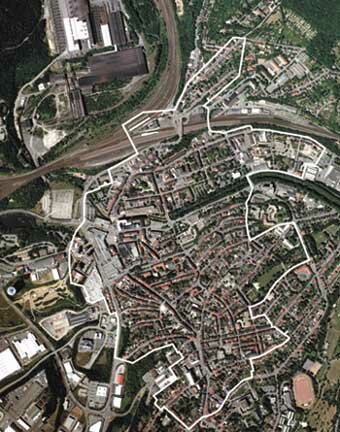 |
The model area (Representation on the basis of digital aerial picture data with the permission of the State Office for Land Registration, Surveying and Cartography Licence No. D-95/01, 13.12.2001) |
After almost complete demolition of the works, a limited extension of the city core became possible. Between 1984 and 1989 the inner city was remodelled and first planning measures carried out in the present model area. For example, the present business centre with a downtown shopping centre ("Saarpark-Center") was built in the eastern part of the model area on land vacated by the historic iron and steel works. The area surrounding the inner city is largely residential but a number of public facilities are also located there, like the city hall, the railway station, and the inland revenue office, and there is a small derelict site on the western fringe. The model area covers both working class neighbourhoods with the traditional block structure, dense development, and multi-storey tenement housing and formerly exclusive neighbourhoods with Jugendstil villas, some listed. Most buildings date from the turn of the century.
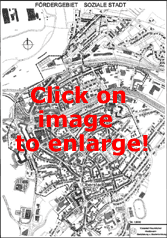 |
Model area Neunkirchen Inner City (Source: Neunkirchen Municipality) |
Differences in altitude of up to 70 metres are to be found in the model area. The steep incline with a gradient of sometimes 20% divides the model area into the Upper Town (Oberstadt) and the Lower Town (Unterstadt), acting as a barrier across which only limited social contacts are maintained.
The demographic and social-space characteristics of the model area point to the problems it faces. In comparison with the city as a whole, there is a high concentration of socially disadvantaged population groups: people who are out of work, who are dependent on social assistance and housing benefits, and foreigners. Overall, however, the situation in the model area is heterogeneous, i.e., socially intact areas alternate in close proximity with areas showing considerable deficiencies. The socially deprived areas are located mainly in the Lower Town and around the Upper Market (Oberer Markt)/Upper Town. Here, for example, 30% of residents depend on social assistance, and in some streets up to 45%.
Owing to major social and urban planning problems, the model area has developed a negative image. Short periods of residence are a clear sign that residents' ties with the district are weak.
2. Main Problems and Development Potential 
In the model area, the central problems are in urban development and in the social and economic fields.
Much of the housing stock is too old and substandard, development shortcomings and deficiencies in the immediate residential environs are widespread. They include disordered, unattractive courtyards, a mixture of polluting industry and housing, a lack of open spaces, and a low quality of sojourn. Since rents are very low and landlords' incomes consequently limited, there is little scope for investment in renovation. As a result, there is deadlock on modernisation in large parts of the model area. A vicious circle develops of low rents, "deprived" tenants, low rental incomes, and a lack of capacity for rehabilitation.
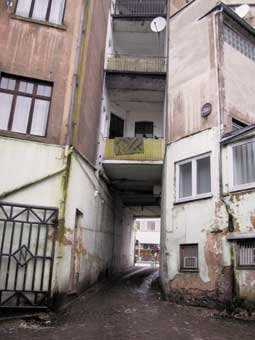 |
Urban development shortcomings in the socially deprived Lower Town (Source: FIRU mbH, Kaiserslautern) |
Given the link between population structure and urban development problems, social problems have been growing particularly in the Lower Town and around the Upper Market. People often move into the neighbourhood because their economic situation obliges, and they move out again when the situation improves. This is also reflected in the low level of identification with the neighbourhood and in the short periods of residence. In 1997 over one third of the population had lived in the inner city for less than three years, and in the Lower Town no less than 50%. This makes the integration of foreigners particularly difficult, since this population group tends to stay for an especially short period. In the public mind, the socially deprived areas also diminish the attractiveness of the model area.
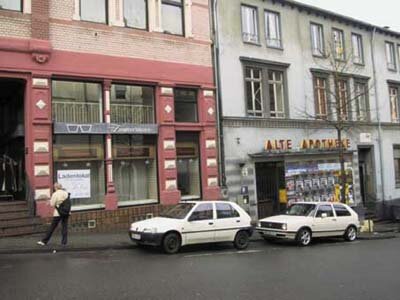 |
Vacant shops in the former main shopping street (Source: FIRU mbH, Kaiserslautern) |
Relations between neighbours are notable problematic. Underdeveloped social ties mean that neighbours often have hardly any contact with one another. The low level of interest among local residents in social and political affairs in apparent in the very low voting rate in elections, under 30%. Young people, in particular, lack communication facilities in the neighbourhood, places where they can meet and spend their free time. One problem closely associated with Neunkirchen's history is the declining fortune of what was once the main shopping street: many shops stand vacant.
Over and above this, unemployment is high in the model area, few jobs are available, and the level of education and training among residents is low. The accumulation of problems has triggered a "self-reinforcing downward spiral."
Despite these problems, the model area has strengths that show potential for development in the context of the "Socially Integrative City" programme. One important resource in the model area is the town centre with the pedestrian precinct, which has already been upgraded through urban renewal measures. The shopping mall "Saarpark-Center," with a catchment area stretching far beyond Neunkirchen, has a positive impact on the image of the city. An image campaign was launched as long ago as the early 1990s. Existing businesses provide model area residents with comparatively good local services, and public facilities like the city hall and schools are nearby.
Demography and Social Space
|
Inner city |
Neunkirchen |
|
|
Size |
107 ha |
7 503 ha |
|
Population (2000) |
10 531 |
52 854 |
|
Population decline (1995–2000) |
n.a. |
0.35 % |
|
Average household size (2000) |
1.8 pers. |
1.8 pers. |
|
Number of dwellings (2000) |
6 070 |
25 294 |
|
Vacant dwelling units |
n.a. |
n.a. |
|
Housing benefit recipients (2000) |
8.3 % |
2.5 % |
|
Unemployment rate (2000) |
23 % |
16.9 % |
|
Social assistance recipients (1999) |
24.0 % |
8.0 % |
|
Foreign population (2000) |
23 % |
9.3 % |
|
Population under 18 (2000) |
21.1 % |
17.9 % |
|
Population 60 and older (2000) |
19.7 % |
25.5 % |
The existing. partly historic building stock and the favourable attitude towards housing modernisation expressed in a survey make improvement of the model area and the provision of high-quality residential locations a practicable proposition.
The many ethnic and social groups who share the model area ensure cultural diversity. Although there are integration problems, no open xenophobia is apparent, so that the model area takes on a multicultural aspect. The many organisations already active in the model area are particularly important for future development; they are very keen to participate and offer a wide range of projects, services, and activities. Another important factor is the high potential for activation among residents recorded by a survey.
3. Development Goals and Focal Points of Action 
The Saarland government programme "City-Vision-Saar" requires the establishment of integrated plans of action in "Socially Integrative City" areas as a precondition for funding. The Neunkirchen municipality has drawn up such a plan for the model area. Although it has not been formally adopted, it forms the basis for implementation of the "Socially Integrative City" programme.
The integrated plan of action analyses the initial situation and characteristics of the programme area from the urban development, social, economic, and ecological points of view. The development strategy elaborated on this basis seeks to achieve the sustainable stabilisation of the model area through targeted measures in these areas.
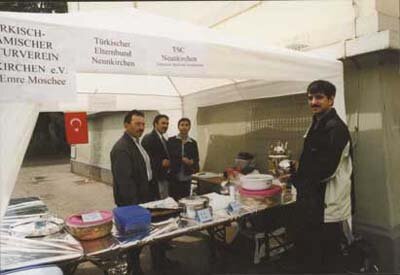 |
Multicultural life in Neunkirchen (Source: District Bureau, Neunkirchen) |
A number of objectives provide the framework for sustainable development in the model area. A balanced social structure is to be restored through the development of socially mixed neighbourhoods and by defusing problem areas. An important aspect in this connection is the interaction between the quality of housing and the social structure of the population. The aim is therefore to achieve a marked qualitative improvement of the housing stock and residential environment. Besides modernising dwellings and carrying out thoroughgoing repairs, existing activity mixes are to be unravelled, the townscape maintained, and security in public spaces improved.
Informal help channels are to be strengthened by developing socio-cultural networks, benefiting socially disadvantaged groups in particular, and countering the tendency towards isolation (e.g., among migrants). The initial goal is to coordinate the many activities, services, and facilities of welfare organisations. Any bottle-necks and gaps are to be remedied by initiating aid services or facilities. This is to be closely accompanied by improvements to the public and welfare infrastructure, e.g., by providing new community amenities (communication, recreation, etc.) and staffing.
Another important objective is to improve the employment and qualification situation. For this purpose neighbourhoods are to be made attractive again for the retail trade, service enterprises, and small industry, and the local economy strengthened. This requires an active labour-market policy, especially for young people, single parents, and the long-term unemployed. Furthermore, neighbourhood-oriented qualification measures are planned, which will be closely associated with ecological and urban design issues.
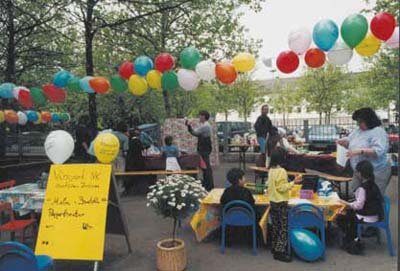 |
Painting and handicrafts for children, organised by social facilities (Source: District Bureau, Neunkirchen) |
The plan also aims to activate local residents by exploiting neighbourhood resources and assisting residents to re-establishing workable community life in the district through help for self-help.
To attain these objectives, measures and projects are planned in the fours areas of action "urban planning and ecology," "community work," "local economy and employment," and "district management and participation." In the framework of the annual updating of the plan of action required in Saarland, these projects are to be supplemented and concretised, taking special account of the ideas and proposals put forward by local actors. Organisational structures are also described in the plan of action, an overview of projects and funding is provided.
Since downtown Neunkirchen has not previously been included in large-scale support or research programmes, the necessary organisational structures have first to be established and inter-authority and inter-actor cooperation made to function. For this reason, implementation of the integrated plan of action in Neunkirchen has got under way relatively slowly. First - mainly building - projects were realised in 2000 and 2001, but many are still in the planning stage.
4. Key Projects 
Individual projects have been carried out in the current term of the "Socially Integrative City" programme in Neunkirchen on the basis of a problems analysis and in keeping with the programme strategy. The creation of a multifunctional sports ground located in the socially deprived Lower Town has been particularly important in attaining programme objectives, because the area lacked communication and recreational facilities. Once the ground had been constructed, a programme of games and sporting events for young people was staged on a total of 14 dates by the Werkhof Wiebelskirchen. The climax was a soccer match between the municipality and young people. "The final against the municipality team was a success with the boys. Some had had their doubts whether 'anyone would turn up&,' but most found it 'cool'. Afterwards they were all enthusiastic - it didn't matter that they'd lost," to quote the "Report on the Bach School Multifunctional Sports Ground" by the Werkhof Wiebelskirchen (Neunkirchen 2001).
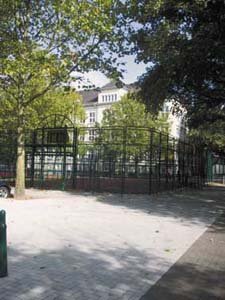 |
New multifunction sports ground in the Lower Town (Source: FIRU mbH, Kaiserslautern) |
Over and beyond these activities, the sports ground was kept under observation at almost all times of the day to evaluate frequentation, the age and sex of users and visitors, uses (soccer, basketball, etc.), the social and group behaviour of users, and acceptance. In effect, the sports ground can be judged a valuable asset for the district. News about the offer of "supervised sport" spread within a few days, and the ground has become an established meeting place for young people. In the short period of supervision, the group behaviour of the adolescents, the need to consider smaller, less adept, or weaker children was recognised. However, it emerged that targeted offers for girls are necessary, who have so far often come only as spectators.
This project has proved an important step towards easing the social situation in the lower town. If supervision of activities can be continued, a sustained impact may be achieved, since brewing conflicts or changes in user structures can be registered at an early point in time. The results of observation could also be used in planning other specific projects in the model area.
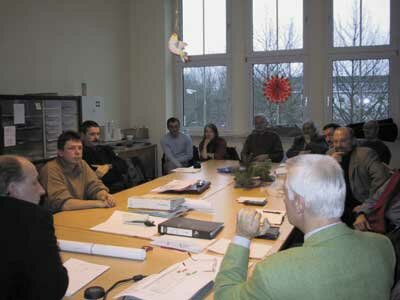 |
Together with the municipality, representatives of various clubs, associations, and institutions hope to find a solution for the district centre at Bach School (Source: FIRU mbH, Kaiserslautern) |
Another important project - still in the planning phase - is to provide attractive venues for socializing and communicating in the Lower Town. Together with the municipality, various institutions, clubs, and associations are endeavouring to combat the lack of integration and communication in the Lower Town. A district centre is hoped to bundle various recreational and communication facilities. Under certain circumstances the Lower Town District Bureau could also be incorporated. The site under consideration is Bach School, a primary school in the heart of the lower town. For years the school has been encouraging extra-curricular activities that promote communication among children and reduce violence and other problems, and it can provide a suitable venue for a contact and meeting point. The concept is being elaborated in intensive collaboration with future users. In discussions with the "Bach School Association" possibilities for extending the building have already been looked into. In early 2002 a planning workshop took place to consider and coordinate the specific demands of various user groups. The next step is to develop a detailed architectural concept taking the results of this workshop into account. In this key project, joint planning and the bundling of various amenities in the heart of the Lower Town in direct association with the school is expected to have a marked integrative impact.
Another key project is the so-called Budgeted Social-Space Youth Programme. Since the beginning of 2000, six youth welfare charities have formed an association (Trägerverbund) to cooperate with the county child welfare office. It operates under the Child and Youth Welfare Act (KJHG) and is accountable to the county as a child and youth welfare institution. The aim is to develop a joint youth welfare programme oriented on the life and social space of the children and adolescents, and their families. This reorganisation allows activities to be bundled and adapted to deal with specific cases. The county makes a certain budget available for the work. If it is not fully spent, the association can use the money for other child and youth welfare projects. Such funds currently finance a social-space team operating in the model area, a "rapid intervention force" that can intervene on the spot when problems arise to do with children and young people. Four part-time "contact social workers" are available to react when help is needed in day-to-day situations. This team can ensure that contact with parents, the organisation of homework help, tips on self-help, and stronger integration of volunteers are provided more rapidly.
5. Organisation and Management 
Control, project management, and responsibility for strategic planning and resource bundling are in the hands of the municipality, which is also in charge of the integrated plan of action. The city adjunct (Beigeordneter) has overall control of the process. The urban planning and development division of the building office is the competent unit, and the social services office has functional responsibility for the District Bureau. Other authorities are called in as needed. The actors at the municipal level are the decision-makers, and have overall responsibility for the complex process of implementing the programme.
However, the guiding principle is to use resources available in the area and to distribute work are broadly as possible. For this reason, institutions, associations, and clubs already active in the model area are involved. The "Socially Integrative City Steering Group" is to ensure networking at the intermediary level. It is an inter-authority and inter-departmental body, composed mainly of representatives from the above-mentioned municipal units. External members are the district management, the management of the municipal housing company, representatives of various organisations, including the child and youth welfare association (Trägerverbund) and the citizens' circle (Bürgerstammtisch). Participation is flexible, depending on the agenda. Sometimes members of the police or of the crime advisory board are called in. The steering group meets at regular intervals to ensure coordination of actors and issues between the municipal and district levels. Its principal tasks are the overall coordination and discussion of planned projects and measures.
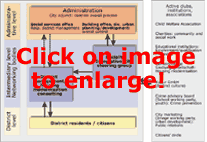 |
Organisational structures in the Neunkirchen Inner City model area (Source: FIRU mbH, Kaiserslautern) |
The district management is another important networking agent for the "Socially Integrative City" programme. The aim is to improve housing and living conditions in the deprived areas, to strengthen residents' identification with their neighbourhood, and to encourage civic engagement and personal initiative.
District management is a central project in community work. For implementation purposes the Neunkirchen municipality cooperates with a local welfare organisation, which is also the organisation that operates the Lower Town District Bureau. Because of the size and heterogeneity of the model area, a second district bureau is planned for the Upper Town. The district manager attends meetings of the steering group, and maintains constant contact with municipal authorities through working meetings. District management stands for innovative neighbourhood development in keeping with the principles of resident activation and the networking of local actors.
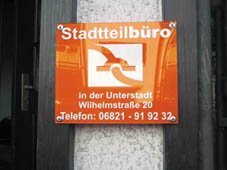 |
The District Bureau, most important contact point in the Lower Town (Source: FIRU mbH, Kaiserslautern) |
Other formal but issue-specific networking structures are provided under a range of cooperation agreements concluded with the municipality. For example, the Gemeinnützige Siedlungsgesellschaft provides advisory services in the field of housing modernisation to complement the work of the district management.
6. Activation, Participation, and Public Relations 
Until the first district bureau was established in May 2001, resident and local actor activation and participation in Neunkirchen focussed on programme planning. When drawing up the integrated plan of action, preparatory seminars and discussions were held with local actors, and an activating survey of neighbourhood residents was conducted; the events were fully documented.
With the advent of the District Bureau, the focus shifted. It now concentrated on public relations work and on publicising the work of the District Bureau (e.g., through flyers, reports in local newspapers, personal communications) and on resident activation through discussions, counselling services, and the organisation of various events (e.g., citizens' circle). Resident participation can be expected only in implementing specific projects, e.g. in discussion rounds and workshops on planning the Lower Town district centre.
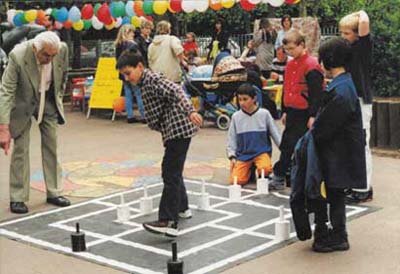 |
Children's games at the Lower Town district festival (Source: District Bureau, Neunkirchen) |
Considering the comparatively short time the District Bureau has been operating in the model area (with one full-time position), it has achieved a great deal in activating the local population - even without a district budget or contingent fund for short-term and spontaneous activities. A well-grounded judgement on how effective the work of the bureau has been can been offered only in the longer term. To achieve sustainable success in the relatively large and heterogeneous model area, a second district bureau with a further full-time position is to be set up as rapidly as possible in the Upper Town. Close cooperation between the municipality, the steering group, and the district bureaus is a particular challenge for the future.
7. Conclusion: The Programme Picks up Speed 
In contrast to many other "Socially Integrative City" model areas, the Neunkirchen inner city had not been included in any other large-scale promotion or research programmes. It was therefore unable to fall back on existing, tried and test structures. In the meanwhile - despite certain problems that still need to be resolved - routine has been established and experience gained in handling the new instruments and procedures.
The next step in implementing the programme will be to update the integrated plan of action - taking careful account of the demands and wishes of the population in the model area. Projects that involve local residents more strongly than before must be tackled. Particular value is also placed on the establishment of the second district bureau in the Upper Town.
More intensive exploitation of the resources existing in the model area offers further potential for development. To this end, the activities and initiatives of local groups can be better integrated and coordinated than to date. This will be an important function of the district bureaus.
In order to do justice to the objectives and demands of the "Socially Integrative City" programme, it is clear that greater and greater input in the way of work, coordination, and management (e.g., resource bundling) is demanded of local actors. This could have a restrictive impact if major actors are overburdened, or even find their capacities exhausted. The continued work of the district bureaus could be hampered by the lack of a contingent fund for Neunkirchen, which narrows the scope for action in the long run.
Im Auftrag des BMVBS vertreten durch das BBR. Zuletzt geändert am 25.05.2005